Related Research Articles
Postal services and telecommunications have long played an essential role in Lebanon, a small country with an expansive diaspora, a vivid media landscape, and an economy geared toward trade and banking. The sector's history has nonetheless been chaotic, marked by conflict but also, and perhaps most importantly, a deeply rooted legacy of state control, weak competition, and intense politicization. A combination of poor services and high prices culminated in popular protests against the government's attempt, in October 2019, to tax the widely used messaging service WhatsApp. The anger this measure triggered captured a more general sense of dissatisfaction, and contributed to tipping the country into a protracted crisis. Civil unrest coincided with Lebanon's default on its ballooning debt; in the ensuing economic collapse, telecommunications have been among the infrastructure most affected.

Martyrs' Square, historically known as "Al Burj" or "Place des Cannons", is the historical central public square of Beirut, Lebanon.
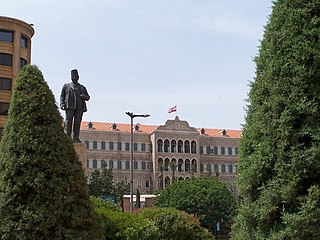
The Grand Serail is the headquarters of the Prime Minister of Lebanon. It is situated atop a hill in downtown Beirut a few blocks away from the Lebanese Parliament building. The Grand Serail is a historic building, the most important of three Ottoman monuments on the Serail hill, the others being the Council for Development and Reconstruction and the Hamidiyyeh clock tower.

The Beirut Central District is the historical and geographical core of Beirut, the capital of Lebanon. Also called downtown Beirut, it has been described as the “vibrant financial, commercial, and administrative hub of the country.” It is thousands of years old, with a traditional focus of business, finance, culture, and leisure.
Joseph Philippe Karam (1923–1976) was a Lebanese architect. He was a leading figure of modern architecture in Lebanon during the country's golden era, 1945 to 1975. Karam founded his practice the Atelier d'Architecture Joseph Philippe Karam in the late 1940s.

Beirut–Rafic Hariri International Airport is the only operational commercial airport in Lebanon. It is located in the Southern Suburbs of Beirut, Lebanon, 9 kilometres (5.6 mi) from the city center. The airport is the hub for Lebanon's national carrier, Middle East Airlines (MEA) and was the hub for the Lebanese cargo carrier TMA cargo and Wings of Lebanon before their respective collapses.

Beirut Souks is a major commercial district in Beirut Central District. With over 200 shops, 25 restaurants and cafes, an entertainment center, a 14 cinema complex, periodic street markets, and an upcoming department store, it is Beirut's largest and most diverse shopping and leisure area. Beirut Souks also features piazzas, and public space. Designed in five separate commissions by international and Lebanese architects, Beirut Souks offer 128,000 sq. m of built-up area interspersed with landscaped pedestrian zones.
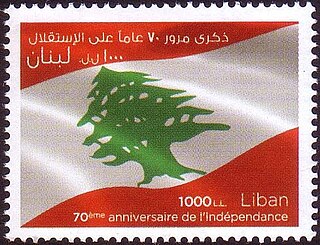
This is a survey of the postage stamps and postal history of Lebanon, formerly known as Liban.
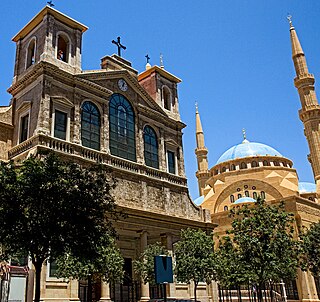
Saint George Maronite Cathedral is the cathedral of the Maronite Catholic Archeparchy of Beirut, Archdiocese of the city of Beirut, Lebanon. Its construction, with a Neoclassical facade, interior and plan inspired by the Basilica di Santa Maria Maggiore, began in 1884 and ended in 1894.

The architecture of Lebanon embodies the historical, cultural and religious influences that have shaped Lebanon's built environment. It has been influenced by the Phoenicians, Romans, Byzantines, Umayyads, Crusaders, Mamluks, Ottomans and French. Additionally, Lebanon is home to many examples of modern and contemporary architecture. Architecturally notable structures in Lebanon include ancient thermae and temples, castles, churches, mosques, hotels, museums, government buildings, souks, residences and towers.

Chennai General Post Office (GPO) is located on Rajaji Salai at Parry's Corner, Chennai. It functions in a building built in 1884. It is located opposite to the Chennai Beach suburban railway station. Chennai GPO covers an area of about 23.33 km2 (9.01 sq mi) and serves a population of around 220,000. It has no sub-branch offices.
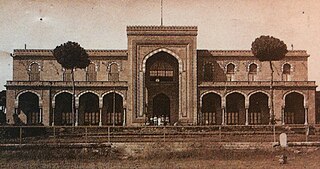
The Pine Residence, located in the Horsh district of Beirut, is the official residence of the French ambassador to Lebanon. The palace holds particular historical importance since General Henri Gouraud declared the creation of the state of Greater Lebanon on September 1, 1920, from its porch.

The Petit Serail was a historic administrative Ottoman building in Beirut that housed the seat of the Wali of Syria and Beirut. It was situated to the northern side of Martyrs' Square at the heart of the Beirut Central District. The building was the scene of important historical events but plans to enlarge Beirut's main square led to its destruction in 1950. It was one of several Ottoman era building projects that shaped the architecture of Lebanon in Beirut.
City Wall and Moat is located in Beirut, Lebanon.
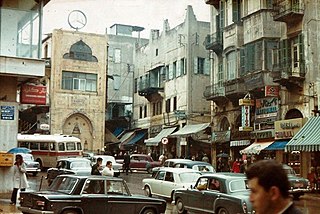
Bab Idriss Square is a square in downtown Beirut, Lebanon.
Souk al-Tawileh is a street located in the heart of downtown Beirut, Lebanon.

The Roman Forum is located in Beirut, Lebanon.

Al-Majidiyyeh Mosque is a mosque located in Beirut, Lebanon.
Harbor Square is a square in Beirut, Lebanon.

The Bank of Syria and Lebanon, from 1919 to 1924 Banque de Syrie, from 1924 to 1939 Banque de Syrie et du Grand-Liban, then Banque de Syrie et du Liban (BSL) from 1939 to 1963, was a French bank that was carved out from the Imperial Ottoman Bank following World War I and granted a central banking role in what would become Syria and Lebanon under French mandate and in the early years of the two countries' independence.